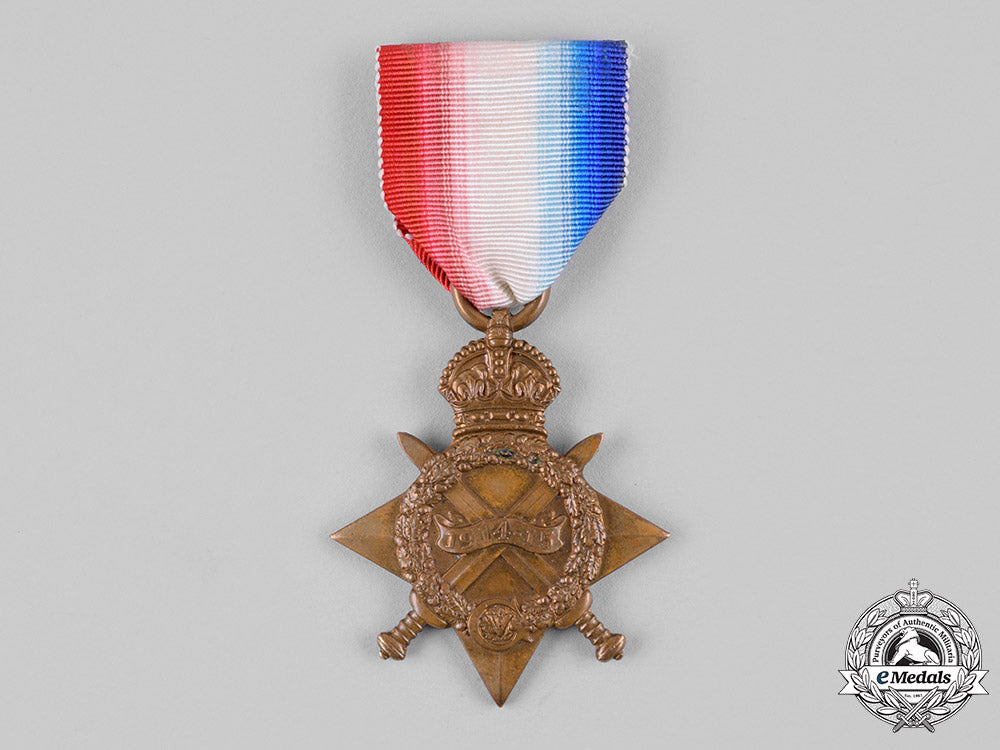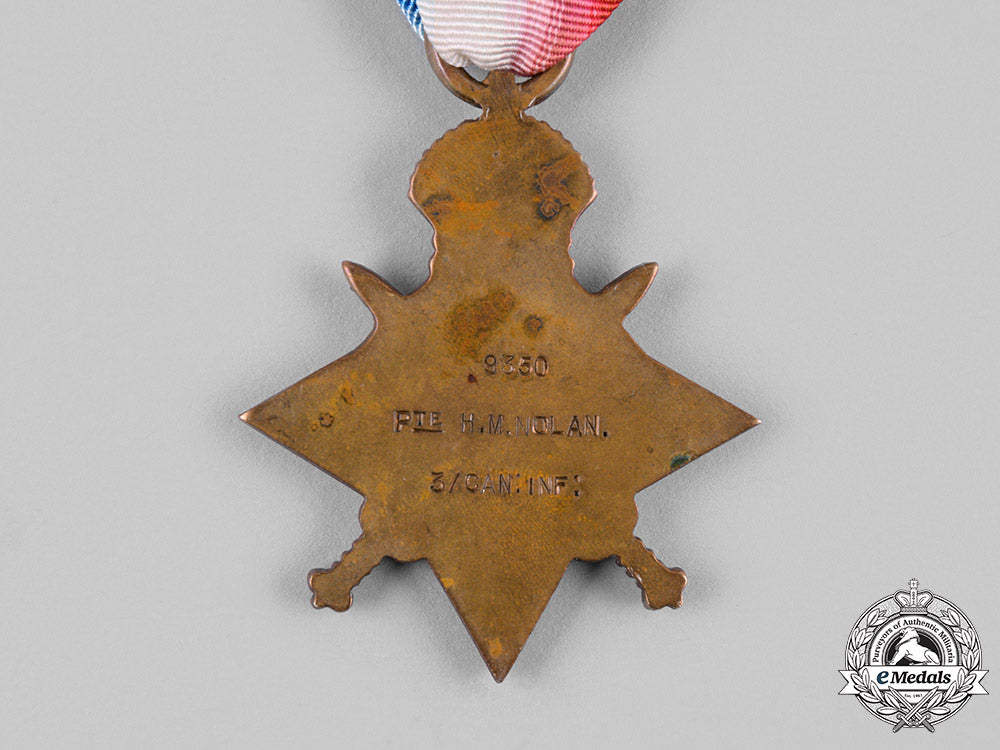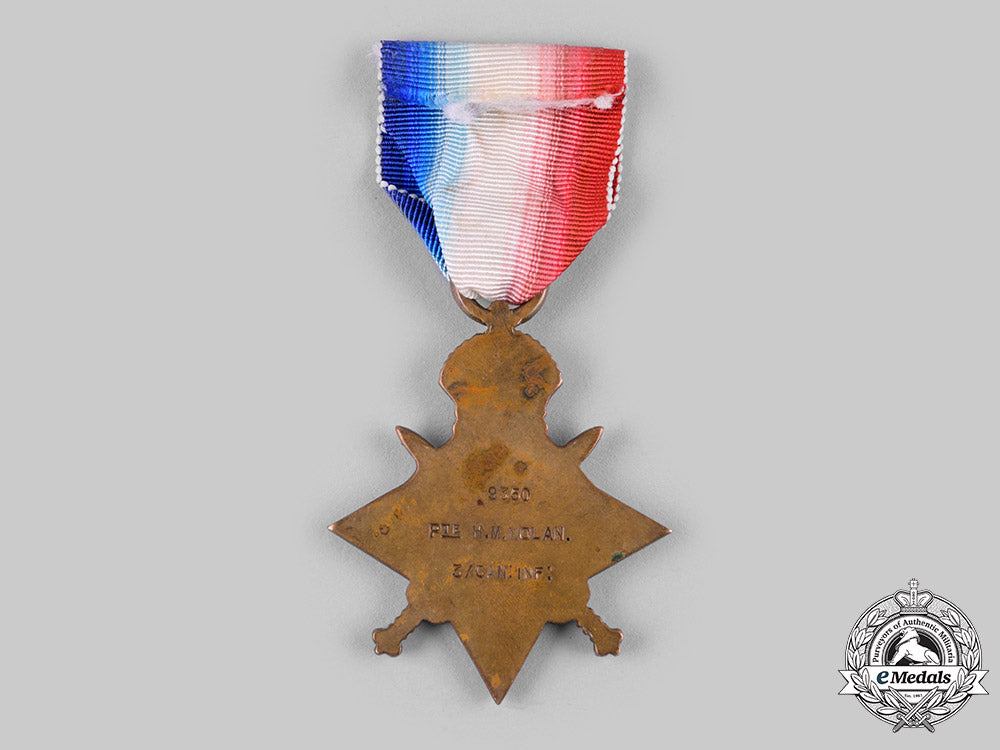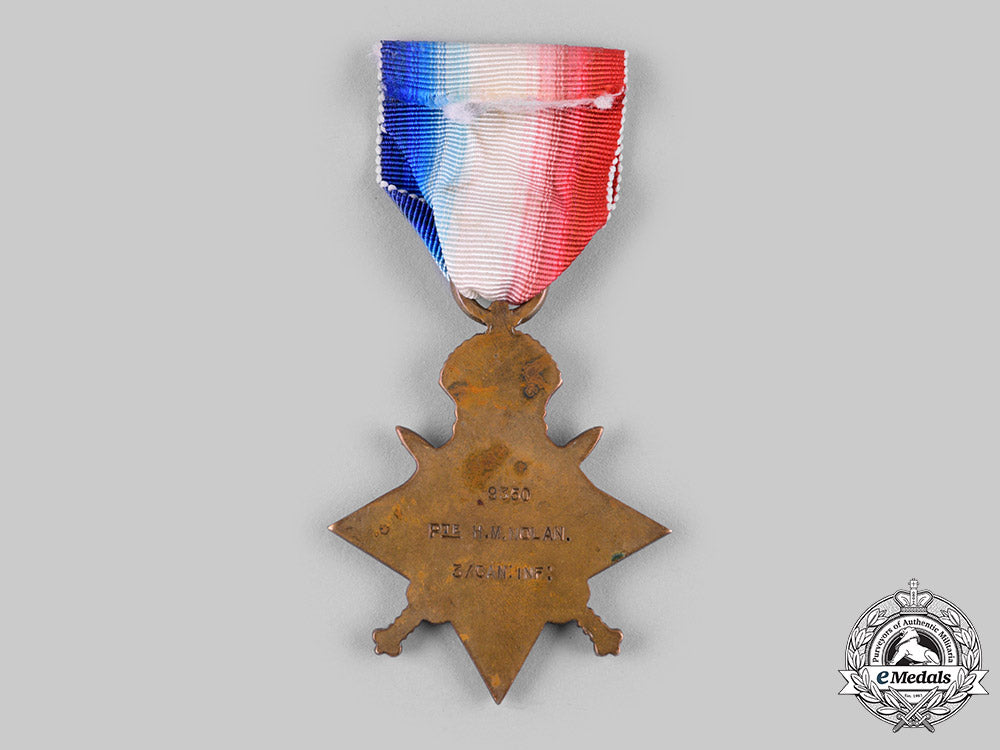
LOADING ...
In response to evolving domestic opinion, eMedals Inc has made the conscious decision to remove the presentation of German Third Reich historical artifacts from our online catalogue. For three decades, eMedals Inc has made an effort to preserve history in all its forms. As historians and researchers, we have managed sensitive articles and materials with the greatest of care and respect for their past and present social context. We acknowledge the growing sentiments put forth by the Canadian public and have taken proactive actions to address this opinion.



Canada, Cef. A 1914-15 Star, 3Rd Infantry Battalion, Canadian Records Office
Canada, Cef. A 1914-15 Star, 3Rd Infantry Battalion, Canadian Records Office
SKU: ITEM: C5938
Current Bid:
Your Max Bid:
Bid History:
Time Remaining:
Couldn't load pickup availability
Shipping Details
Shipping Details
eMedals offers rapid domestic and international shipping. Orders received prior to 12:00pm (EST) will be shipped on the same business day.* Orders placed on Canadian Federal holidays will be dispatched the subsequent business day. Courier tracking numbers are provided for all shipments. All items purchased from eMedals can be returned for a full monetary refund or merchandise credit, providing the criteria presented in our Terms & Conditions are met. *Please note that the addition of a COA may impact dispatch time.
Shipping Details
eMedals offers rapid domestic and international shipping. Orders received prior to 12:00pm (EST) will be shipped on the same business day.* Orders placed on Canadian Federal holidays will be dispatched the subsequent business day. Courier tracking numbers are provided for all shipments. All items purchased from eMedals can be returned for a full monetary refund or merchandise credit, providing the criteria presented in our Terms & Conditions are met. *Please note that the addition of a COA may impact dispatch time.
Description
Description
(9350 Pte H.M. NOLAN. 3/CAN:INF:). Naming is officially impressed. Spotting, very light contact, replacement ribbon, better than very fine.
Footnote: Herbert Montegue Nolan was born on January 15, 1886 in Richmond, Surrey, England, the son of Herbert Nolan and Elizabeth Nolan (nee Turner). He had Smallpox in 1903, at the age of 17 but made a "good recovery". Nolan enlisted with the 3rd Infantry Battalion on August on August 15, 1914 in Toronto, Ontario. He signed his Attestation Paper as a Private (9350) with the 3rd Infantry Battalion on September 22, 1914 at Valcartier Camp, at the age of 28, naming his next-of-kin as his friend, John McCallum of Toronto, stating that he had no previous military service, that he was not married, that his religion was Church of England and that his trade was that of Accountant. The Battalion was raised in Toronto with mobilization headquarters at Camp Valcartier, Quebec under the authority of P.C.O. 2067, August 6, 1914.
The Battalion sailed from Quebec City, Quebec aboard the S.S. Tunisian on October 3, 1914 under the command of Lieutenant-Colonel R. Rennie with a strength of 43 officers and 1,100 other ranks. Nolan's pay would later be re-directed to Miss R.W. Biggs of Lambeth, London. After four months orientation and training in England with "A" Company, 3rd Infantry Battalion, he was transferred overseas for service in the French theatre, arriving in France on February 11, 1915. He was in the trenches at Cuinchy, Pas-de-Calais when he was exposed to a gas attack on June 15, 1915. He was initially admitted to No. 1 Canadian Field Ambulance, then transferred and admitted to No. 1 Canadian General Hospital at Etaples on June 20th, suffering from "Asthma". In his Medical Case Sheet, the attending physician noted that Nolan "has been suffering from Asthma for years. Was in very good health at Valcartier and until arrival in England. Had a few paroxysms (a sudden attack or violent expression of a particular emotion or activity) in England but since arrival in France, they have increased in severity and frequency".
He was soon invalided to England aboard a Hospital Ship, posted to the 23rd Reserve Battalion at Shorncliffe and admitted to the Military Hospital at Colchester on June 22nd. He would be treated at Colchester for almost five weeks, before being transferred to the Canadian Convalescent Hospital, Monks Horton on July 25th. In his Medical Report of an Invalid, dated August 2, 1915 at Monks Horton, the encounter to the gas exposure at Cuinchy, Pas-de-Calais on June 15, 1915 was documented: "As a result of fumes from the bursting shells, (he) began wheezing all the time at first and later only at night. Since then he has had trouble every night, with asthma attacks. His father and grandfather has asthma and he suffered from asthma from (the) age of 17 but was relieved in Canada during his stay from (the) age of 20 to 22 and again from (the) age of 26 till June 15th, 1915. Damp atmosphere particularly affects him for the worse. Is of nervous temperament. Heart rapid but otherwise normal. Lungs normal, save for an indication of emphysema. Is rather thin and anemic".
The doctor declared Nolan's condition to be a "permanent disability" and recommended that a "change" in status be made; that he remain in England to do "clerical work". Private Nolan attended the Pay Office (AKA the Canadian Records Office) in London, placed on command on September 3, 1915. He was transferred to the 12th Reserve Battalion on April 25, 1916. A month later, now age 30, he was examined for his "Asthma" by a Standing Medical Board at London on May 19th, where the doctor noted that Nolan had an "occasional attack". He was promoted to Acting Corporal on September 1, 1916, named a Group Clerk on September 15, 1916 and promoted to Acting Sergeant on December 1, 1916. He was taken on strength at 1st Central Ontario Regimental Depot and attended the Canadian Record Office at London as of March 10, 1917. Nolan was promoted to Acting Staff Sergeant on June 1, 1917, then appointed Deputy Sup. Clerk at London on January 14, 1918 and was appointed Acting Staff Quartermaster Sergeant (Warrant Officer, Class 2), Supt. Clerk on April 1, 1918. He had an attack of Influenza in 1918 and made a "good recovery". Almost one year later, Acting Staff Quartermaster Sergeant Nolan was still in London at the Canadian Records Office, when he was recommended for promotion to Acting Sergeant Major (Warrant Officer, Class 1) on March 15, 1919, at the age of 33, as it was noted that he was "fully qualified for the appointment". Nolan was admitted to Grove Military Hospital at Tooting on June 17, 1919 with a "Boil" on his right knee, which would later be discovered on other parts of his body. After nine days at Grove, he was transferred and admitted to No. 16 Canadian General Hospital at Orpington on June 26th with "Adenitis" (general term for an inflammation of a gland), having had a "gland drained, several boils opened....vaccine prepared". In his Medical History of an Invalid Report, dated July 18, 1919 at No. 16 Canadian General Hospital at Orpington, Nolan was still attached to the Canadian Records Office at the time. The attending physician discussed Nolan's two conditions: firstly, the Asthma, which was chronic, noting that he had had frequent attacks of Dyspnoea (shortness of breath) on stuffy nights and damp weather, along with shortness of breath on exertion. He noted that Nolan had been in the trenches in France in June 1915, when they were shelled with Lyddite shells and that he inhaled the fumes and was invalided to England with Asthma. Nolan told him that he had no Asthma before enlisting. The doctor noted that it was a "permanent disability" and that Nolan required hospitalization for it. Secondly, doctor discussed the Furunculosis (a deep infection of the hair follicle leading to abscess formation with accumulation of pus and necrotic tissue) that Nolan had acquired in England. He noted that Nolan had boils in both auxillas (the area on the human body directly under the joint where the arm connects to the shoulder and provides the underarm sweat gland) and on the abdominal wall and right knee, that it was causing tenderness in the region of the boils. While on duty in London, Nolan had developed a boil on the right knee, with Adenitis of the groin developing by June 17th, at which point he was admitted to Grove Military Hospital, then transported to Orpington on June 25th. The doctor estimated that he would require two months' treatment and recommended that he be designated Category D (Temporarily Unfit) and be invalided to Canada.
Nolan was transferred and admitted to No. 5 Canadian General Hospital at Liverpool on July 25th, where he would be treated for two weeks, before being invalided to Canada. He embarked for Canada aboard the S.S. Araguaya on August 8, 1919, arriving in Portland shortly thereafter. Upon arrival at No. 2 Military District in Toronto, he was posted to St. Andrews Military Hospital in North Rosedale, Toronto on August 19, 1919, where he was treated for his Asthma. It is noted in his records that he had a Tonsillectomy performed in December 1919, receiving a "good result". He received dental treatment on January 10, 1920, which had been nearly completed by February 11th and was to be completed after his discharge, the physician stating that the "patient also has had several teeth extracted to improve general condition - pyorrhea condition" (periodontitis). He recommended that Nolan be discharged to D.S.C.R., as an outpatient for observation for three weeks for (the) occurrence of (an) attack". The doctor also stated that "It is certified that the invalid does not require treatment (and that he) should pass under his own control. It is recommended that the invalid be discharged" (as Medically Unfit). In Acting Sergeant Major Nolan's Medical History of an Invalid Report, dated February 10, 1920 at St. Andrews, the attending physician noted that he had "Partial loss of function of (the) respiratory system, chronic asthma". He went on to detail Nolan's history with the malady: "Since returning to Canada, the asthmatic attacks have not been as severe or frequent as in England, but they come on, especially in damp weather - no attacks have been seen since (the) patient's admission to hospital - patient complains of shortness of breath on exertion". Acting Sergeant Major (Warrant Officer, Class 1) Herbert Montague Nolan, 3rd Infantry Battalion, Canadian Records Office was "discharged from the service by reason of Medical Unfitness" at No. 2 District Depot in Toronto on February 17, 1920 and was to take further outpatient treatment with the Department of S.C.R. (D.S.C.R.). He was credited with having served in Canada, England and France, entitled to wear the War Service Badge, Class "A", number 221247 and was entitled to 183 days' War Service Gratuity.
For his First World War service, he was awarded the 1914-15 Star, the British War Medal and the Victory Medal. After the war, he married Bessie Muriel Nolan (nee McCreary) on October 16, 1922. The couple were later to have a daughter, Susan Elizabeth Nolan, born on March 28, 1929 in Toronto, who herself would marry William Alexander Leckie in Toronto on June 16, 1951. Herbert Montague Nolan died at Sunnybrook Medical Centre in Toronto, on March 18, 1959, at the age of 73. His funeral took place at Humphrey Funeral Home on March 20th, followed by his cremation at the Toronto Crematorium.
Description
(9350 Pte H.M. NOLAN. 3/CAN:INF:). Naming is officially impressed. Spotting, very light contact, replacement ribbon, better than very fine.
Footnote: Herbert Montegue Nolan was born on January 15, 1886 in Richmond, Surrey, England, the son of Herbert Nolan and Elizabeth Nolan (nee Turner). He had Smallpox in 1903, at the age of 17 but made a "good recovery". Nolan enlisted with the 3rd Infantry Battalion on August on August 15, 1914 in Toronto, Ontario. He signed his Attestation Paper as a Private (9350) with the 3rd Infantry Battalion on September 22, 1914 at Valcartier Camp, at the age of 28, naming his next-of-kin as his friend, John McCallum of Toronto, stating that he had no previous military service, that he was not married, that his religion was Church of England and that his trade was that of Accountant. The Battalion was raised in Toronto with mobilization headquarters at Camp Valcartier, Quebec under the authority of P.C.O. 2067, August 6, 1914.
The Battalion sailed from Quebec City, Quebec aboard the S.S. Tunisian on October 3, 1914 under the command of Lieutenant-Colonel R. Rennie with a strength of 43 officers and 1,100 other ranks. Nolan's pay would later be re-directed to Miss R.W. Biggs of Lambeth, London. After four months orientation and training in England with "A" Company, 3rd Infantry Battalion, he was transferred overseas for service in the French theatre, arriving in France on February 11, 1915. He was in the trenches at Cuinchy, Pas-de-Calais when he was exposed to a gas attack on June 15, 1915. He was initially admitted to No. 1 Canadian Field Ambulance, then transferred and admitted to No. 1 Canadian General Hospital at Etaples on June 20th, suffering from "Asthma". In his Medical Case Sheet, the attending physician noted that Nolan "has been suffering from Asthma for years. Was in very good health at Valcartier and until arrival in England. Had a few paroxysms (a sudden attack or violent expression of a particular emotion or activity) in England but since arrival in France, they have increased in severity and frequency".
He was soon invalided to England aboard a Hospital Ship, posted to the 23rd Reserve Battalion at Shorncliffe and admitted to the Military Hospital at Colchester on June 22nd. He would be treated at Colchester for almost five weeks, before being transferred to the Canadian Convalescent Hospital, Monks Horton on July 25th. In his Medical Report of an Invalid, dated August 2, 1915 at Monks Horton, the encounter to the gas exposure at Cuinchy, Pas-de-Calais on June 15, 1915 was documented: "As a result of fumes from the bursting shells, (he) began wheezing all the time at first and later only at night. Since then he has had trouble every night, with asthma attacks. His father and grandfather has asthma and he suffered from asthma from (the) age of 17 but was relieved in Canada during his stay from (the) age of 20 to 22 and again from (the) age of 26 till June 15th, 1915. Damp atmosphere particularly affects him for the worse. Is of nervous temperament. Heart rapid but otherwise normal. Lungs normal, save for an indication of emphysema. Is rather thin and anemic".
The doctor declared Nolan's condition to be a "permanent disability" and recommended that a "change" in status be made; that he remain in England to do "clerical work". Private Nolan attended the Pay Office (AKA the Canadian Records Office) in London, placed on command on September 3, 1915. He was transferred to the 12th Reserve Battalion on April 25, 1916. A month later, now age 30, he was examined for his "Asthma" by a Standing Medical Board at London on May 19th, where the doctor noted that Nolan had an "occasional attack". He was promoted to Acting Corporal on September 1, 1916, named a Group Clerk on September 15, 1916 and promoted to Acting Sergeant on December 1, 1916. He was taken on strength at 1st Central Ontario Regimental Depot and attended the Canadian Record Office at London as of March 10, 1917. Nolan was promoted to Acting Staff Sergeant on June 1, 1917, then appointed Deputy Sup. Clerk at London on January 14, 1918 and was appointed Acting Staff Quartermaster Sergeant (Warrant Officer, Class 2), Supt. Clerk on April 1, 1918. He had an attack of Influenza in 1918 and made a "good recovery". Almost one year later, Acting Staff Quartermaster Sergeant Nolan was still in London at the Canadian Records Office, when he was recommended for promotion to Acting Sergeant Major (Warrant Officer, Class 1) on March 15, 1919, at the age of 33, as it was noted that he was "fully qualified for the appointment". Nolan was admitted to Grove Military Hospital at Tooting on June 17, 1919 with a "Boil" on his right knee, which would later be discovered on other parts of his body. After nine days at Grove, he was transferred and admitted to No. 16 Canadian General Hospital at Orpington on June 26th with "Adenitis" (general term for an inflammation of a gland), having had a "gland drained, several boils opened....vaccine prepared". In his Medical History of an Invalid Report, dated July 18, 1919 at No. 16 Canadian General Hospital at Orpington, Nolan was still attached to the Canadian Records Office at the time. The attending physician discussed Nolan's two conditions: firstly, the Asthma, which was chronic, noting that he had had frequent attacks of Dyspnoea (shortness of breath) on stuffy nights and damp weather, along with shortness of breath on exertion. He noted that Nolan had been in the trenches in France in June 1915, when they were shelled with Lyddite shells and that he inhaled the fumes and was invalided to England with Asthma. Nolan told him that he had no Asthma before enlisting. The doctor noted that it was a "permanent disability" and that Nolan required hospitalization for it. Secondly, doctor discussed the Furunculosis (a deep infection of the hair follicle leading to abscess formation with accumulation of pus and necrotic tissue) that Nolan had acquired in England. He noted that Nolan had boils in both auxillas (the area on the human body directly under the joint where the arm connects to the shoulder and provides the underarm sweat gland) and on the abdominal wall and right knee, that it was causing tenderness in the region of the boils. While on duty in London, Nolan had developed a boil on the right knee, with Adenitis of the groin developing by June 17th, at which point he was admitted to Grove Military Hospital, then transported to Orpington on June 25th. The doctor estimated that he would require two months' treatment and recommended that he be designated Category D (Temporarily Unfit) and be invalided to Canada.
Nolan was transferred and admitted to No. 5 Canadian General Hospital at Liverpool on July 25th, where he would be treated for two weeks, before being invalided to Canada. He embarked for Canada aboard the S.S. Araguaya on August 8, 1919, arriving in Portland shortly thereafter. Upon arrival at No. 2 Military District in Toronto, he was posted to St. Andrews Military Hospital in North Rosedale, Toronto on August 19, 1919, where he was treated for his Asthma. It is noted in his records that he had a Tonsillectomy performed in December 1919, receiving a "good result". He received dental treatment on January 10, 1920, which had been nearly completed by February 11th and was to be completed after his discharge, the physician stating that the "patient also has had several teeth extracted to improve general condition - pyorrhea condition" (periodontitis). He recommended that Nolan be discharged to D.S.C.R., as an outpatient for observation for three weeks for (the) occurrence of (an) attack". The doctor also stated that "It is certified that the invalid does not require treatment (and that he) should pass under his own control. It is recommended that the invalid be discharged" (as Medically Unfit). In Acting Sergeant Major Nolan's Medical History of an Invalid Report, dated February 10, 1920 at St. Andrews, the attending physician noted that he had "Partial loss of function of (the) respiratory system, chronic asthma". He went on to detail Nolan's history with the malady: "Since returning to Canada, the asthmatic attacks have not been as severe or frequent as in England, but they come on, especially in damp weather - no attacks have been seen since (the) patient's admission to hospital - patient complains of shortness of breath on exertion". Acting Sergeant Major (Warrant Officer, Class 1) Herbert Montague Nolan, 3rd Infantry Battalion, Canadian Records Office was "discharged from the service by reason of Medical Unfitness" at No. 2 District Depot in Toronto on February 17, 1920 and was to take further outpatient treatment with the Department of S.C.R. (D.S.C.R.). He was credited with having served in Canada, England and France, entitled to wear the War Service Badge, Class "A", number 221247 and was entitled to 183 days' War Service Gratuity.
For his First World War service, he was awarded the 1914-15 Star, the British War Medal and the Victory Medal. After the war, he married Bessie Muriel Nolan (nee McCreary) on October 16, 1922. The couple were later to have a daughter, Susan Elizabeth Nolan, born on March 28, 1929 in Toronto, who herself would marry William Alexander Leckie in Toronto on June 16, 1951. Herbert Montague Nolan died at Sunnybrook Medical Centre in Toronto, on March 18, 1959, at the age of 73. His funeral took place at Humphrey Funeral Home on March 20th, followed by his cremation at the Toronto Crematorium.



You May Also Like
Japan, Empire. A T90 Civil Defense Helmet, c.1943
W8287
Germany, SA. A Model 1933 Service Dagger, SA-Gruppe Nordsee, by Friedrich von der Kohlen
G59818
Germany, SA. A Model 1933 Service Dagger, SA-Gruppe Pommern, by Gustav Wirth
G59816
Germany, Third Reich. A Mixed Lot of Tyrolean Marksmanship Badges
G52930
Germany, SS. An Estonian Waffen-SS Volunteer’s Sleeve Shield
G50381
-
Japan, Empire. A T90 Civil Defense Helmet, c.1943
W8287
Add to CartRegular price $275 USDRegular price $0 USD Sale price $275 USDUnit price / per -
Germany, SA. A Model 1933 Service Dagger, SA-Gruppe Nordsee, by Friedrich von der Kohlen
G59818
Add to CartRegular price $980 USDRegular price $0 USD Sale price $980 USDUnit price / per -
Germany, SA. A Model 1933 Service Dagger, SA-Gruppe Pommern, by Gustav Wirth
G59816
Add to CartRegular price $980 USDRegular price $0 USD Sale price $980 USDUnit price / per -
Germany, Third Reich. A Mixed Lot of Tyrolean Marksmanship Badges
G52930
Add to CartRegular price $135 USDRegular price $0 USD Sale price $135 USDUnit price / per -
Germany, SS. An Estonian Waffen-SS Volunteer’s Sleeve Shield
G50381
Add to CartRegular price $150 USDRegular price $0 USD Sale price $150 USDUnit price / per
Do you have a similar item you are interested in selling?
Please complete the form and our client care representatives will contact you.
Sell Item










